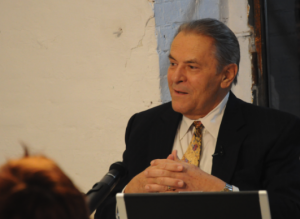Stanislav Grof: His Life and Work

Stanislav Grof is one of the most influential figures in psychology. He has made a name for himself through fascinating research on altered states of consciousness and holotropic breathwork. He’s also one of the founders of one of the biggest trends in recent psychology: transpersonal psychology.
Stanislav Grof was born on July 1st, 1931, in Prague, Czechia. He studied medicine and psychiatry. He also studied Freudian psychoanalysis for over seven years. Stanislav has more than 50 years of research and clinical practice under his belt. Amazing, right?
In this article, we’re going to talk about a man who has studied the mind through psychedelic drugs and summarize his big contributions to psychology.
“Western Science is approaching a paradigm shift of unprecedented proportions, one that will change our concepts of reality and of human nature, bridge the gap between ancient wisdom and modern science, and reconcile the differences between Eastern spirituality and Western pragmatism.”
-Stanislav Grof-
Stanislav Grof and transpersonal psychology
The term transpersonal psychology was coined in 1969, partly thanks to Grof. He worked alongside other researchers such as Jamer Fadiman Miles Vich, Sonya Marguiles, and Anthony Sutich. He also worked alongside Abraham Maslow and Ken Wilber. In 1978, Grof founded the International Transpersonal Association.
Grof believed that other branches of psychology didn’t focus enough on spirituality, which is why he thought we could better understand the human mind through patient-based research. This is how he proved that spirituality is a legitimate part of our psyche.
Thanks to his clinical practice, his transpersonal psychology research, and the contributions of other researchers, psychology is now much broader.

Stanislav Grof and psychedelic drugs
Grof volunteered for an LSD study at First Faculty of Medicine, Charles University Prague. This was his first experience with the substance. Afterward, he started studying all kinds of substances and their effects on the brains. Along with other researchers, he studied psilocybin, LSD, and mescaline with a group of 40 people.
They carried out many psycho-technical tests and physical exams to see if the substances had specific effects or produced similar states when taken together. In Grof’s words, they also wanted to see if it caused “experimental psychosis,” which would help them decode the mystery of psychosis.
Grof spent 20 years doing psychotherapy with psychedelic drugs in Prague and the USA. But after the research was banned due to the supposed damage it could cause chromosomes, he started working at the Esalen Institute. During this time, he wrote his first book.
Holotropic breathwork
After he started working at the Esalen Institute, he also developed the concept of holotropic breathwork with Christina Grof. The technique can produce states similar to the ones psychedelic drugs produce.
The word “holotropic” comes from the Greek “holos” (whole) and “trep” (to turn). So, holotropic means moving or turning towards wholeness. It’s a kind of self-exploration where you engage your conscious mind. It also involves different spiritual traditions.
According to transpersonal psychology, negative symptoms and mental blocks result from forgetting or repressing things. The theory was that we could reach those things in states of expanded consciousness or holotropic states.
Holotropic sessions include many different states of consciousness, sometimes returning to the moment of your birth or even farther back in time.

Grof’s books
Grof has published over 160 books and articles. Here are some of his most interesting ones:
- The Stormy Search for the Self: A Guide to Personal Growth through Transformative Crisis. This is a self-help book. In it, Grof talks about states of consciousness that some cultures see as psychotic. It’s a great example of how complex mental states can be a good thing.
- The Holotropic Mind: The Three Levels of Human Consciousness and How They Shape Our Lives. In this book, Grof talks about his experiences with transpersonal psychotherapy. He also shows how past experiences, mystical experiences, death, and rebirth are all related.
- LSD Psychotherapy. This book made Grof famous. It’s basically a guide on how to use LSD in psychotherapy.
- When the Impossible Happens: Adventures in Non-Ordinary Realities. This is Grof’s psychonaut autobiography.
- Beyond the Brain: Birth, Death, and Transcendence in Psychotherapy. In this book, Grof talks about the basic ideas and benefits of transpersonal psychology. He also calls into question the therapeutic models of other branches of psychiatry.
Stanislav Grof is currently a professor of Psychology at the California Institute of Integral Studies (CIIS) in San Francisco. He married Brigitte Grof in 2016. They travel the world together teaching seminars and workshops on the holotropic breathwork to help spread the word of the technique.
All cited sources were thoroughly reviewed by our team to ensure their quality, reliability, currency, and validity. The bibliography of this article was considered reliable and of academic or scientific accuracy.
- Grof, S. (2002). Breve historia de la psicología transpersonal. Journal of transpersonal research, 2(2), 125-136.
- Grof, S. (1994). Psicología transpersonal: nacimiento, muerte y trascendencia en psicoterapia. Editorial Kairós.
- Puente, I. (2014). “Entrevista a Stanislav Grof: Psicología y Respiración Holotópica”. Recuperado de: http:/www.stanislavgrof.com, 20 (10).
This text is provided for informational purposes only and does not replace consultation with a professional. If in doubt, consult your specialist.








